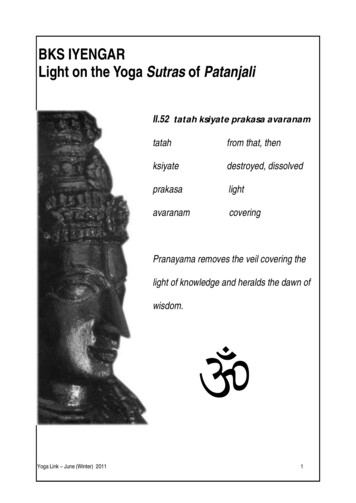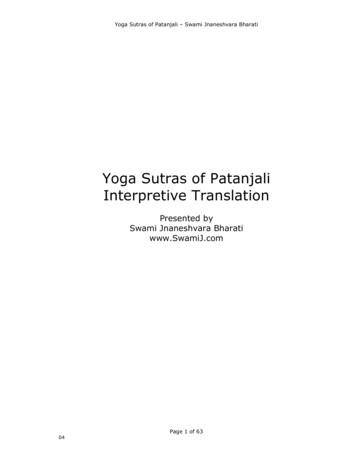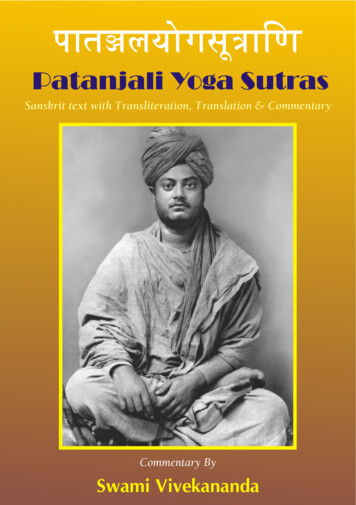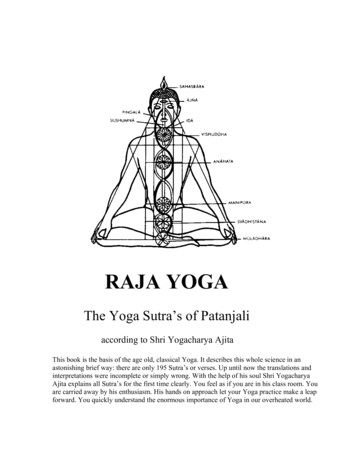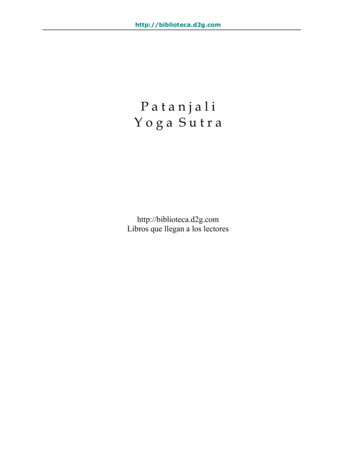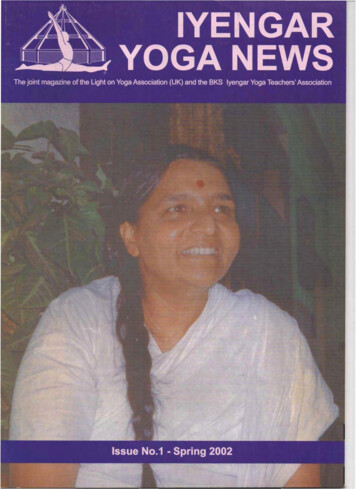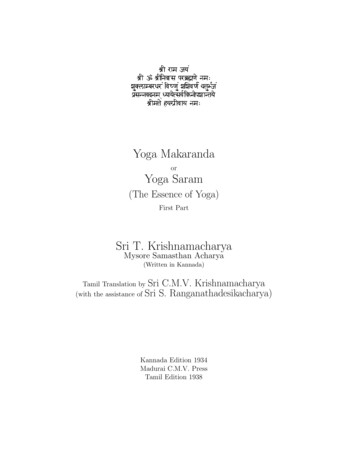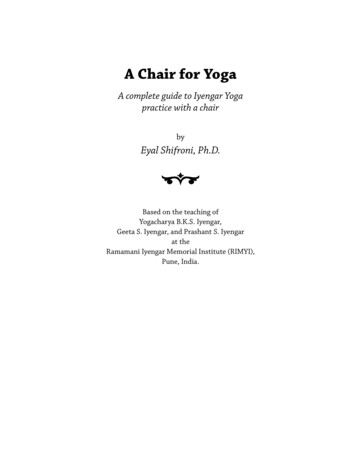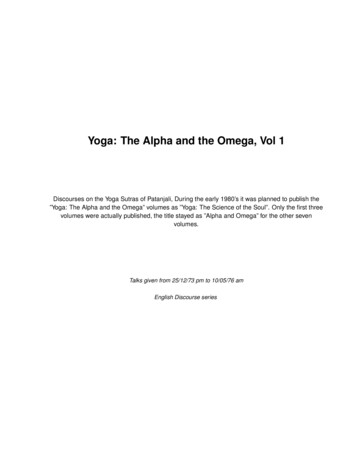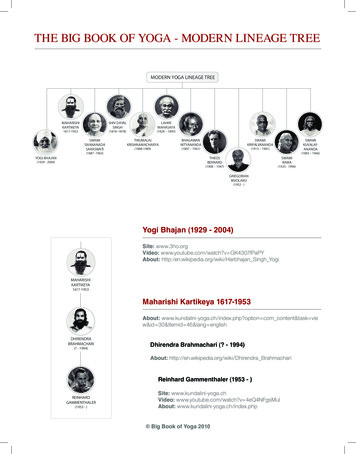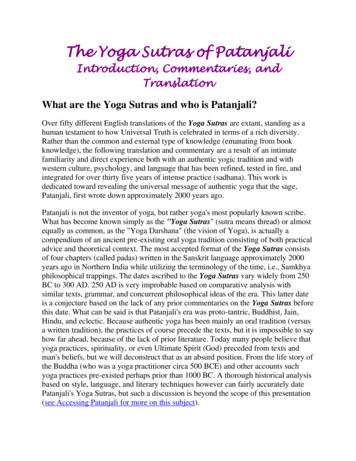
Transcription
The Yoga Sutras of PatanjaliIntroduction, Commentaries, andTranslationWhat are the Yoga Sutras and who is Patanjali?Over fifty different English translations of the Yoga Sutras are extant, standing as ahuman testament to how Universal Truth is celebrated in terms of a rich diversity.Rather than the common and external type of knowledge (emanating from bookknowledge), the following translation and commentary are a result of an intimatefamiliarity and direct experience both with an authentic yogic tradition and withwestern culture, psychology, and language that has been refined, tested in fire, andintegrated for over thirty five years of intense practice (sadhana). This work isdedicated toward revealing the universal message of authentic yoga that the sage,Patanjali, first wrote down approximately 2000 years ago.Patanjali is not the inventor of yoga, but rather yoga's most popularly known scribe.What has become known simply as the "Yoga Sutras" (sutra means thread) or almostequally as common, as the "Yoga Darshana" (the vision of Yoga), is actually acompendium of an ancient pre-existing oral yoga tradition consisting of both practicaladvice and theoretical context. The most accepted format of the Yoga Sutras consistsof four chapters (called padas) written in the Sanskrit language approximately 2000years ago in Northern India while utilizing the terminology of the time, i.e., Samkhyaphilosophical trappings. The dates ascribed to the Yoga Sutras vary widely from 250BC to 300 AD. 250 AD is very improbable based on comparative analysis withsimilar texts, grammar, and concurrent philosophical ideas of the era. This latter dateis a conjecture based on the lack of any prior commentaries on the Yoga Sutras beforethis date. What can be said is that Patanjali's era was proto-tantric, Buddhist, Jain,Hindu, and eclectic. Because authentic yoga has been mainly an oral tradition (versusa written tradition), the practices of course precede the texts, but it is impossible to sayhow far ahead, because of the lack of prior literature. Today many people believe thatyoga practices, spirituality, or even Ultimate Spirit (God) preceded from texts andman's beliefs, but we will deconstruct that as an absurd position. From the life story ofthe Buddha (who was a yoga practitioner circa 500 BCE) and other accounts suchyoga practices pre-existed perhaps prior than 1000 BC. A thorough historical analysisbased on style, language, and literary techniques however can fairly accurately datePatanjali's Yoga Sutras, but such a discussion is beyond the scope of this presentation(see Accessing Patanjali for more on this subject).
For our purpose we will accept the entire traditional four chapters of the "YogaSutras" as being authentic (although acknowledging the controversy as to thepossibility of additional sutras being added post-humorously). Although classicalIndian historians pay little detail to linear aspects of time, suffice it to say that theYoga Sutras were most likely penned somewhere around the time of Jesus, plus orminus 200 years. We will assume that Patanjali was an educated man who in hismiddle or latter life received oral instruction in raj yoga practices and took up thepractices of yoga in the remote caves, forests, or river banks which were the mostfrequent practicing grounds of the time. There Patanjali the yogi, gained the siddha(perfection) of nirbija samadhi (seedless samadhi), the crown achievement of yoga.As the remote havens of the yogis were receding and the true aspirants dwindling, it isthought that Patanjali decided to record the most essential Yoga teachings which washis guide and inspiration to enlightenment.As a system, the type of yoga as put forth by Patanjali, is non-theistic, having not eventhe slightest suggestion of worshipping idols, deities, gurus, or sacred books; but atthe same time it does not contain any atheistic doctrine either. Although this fact hasbeen contested by self interested groups, a careful unbiased study of the Yoga Sutras,especially the discussion of what Patanjali means by the word, "isvara", will prove theaforesaid fact as incontestable.Meditation (dhyana), Practice (abhyasa), and Vairagya(non-grasping) are the KeysWithin the broad category of what is called yoga, the Yoga Sutras most properlybelong to the school of Raj (Royal) Yoga, which succinctly can be defined as yogapractices which are culminated in meditation (dhyana) leading to samadhi. A carefulreading of the Yoga Sutras will reveal to the astute meditator, an elucidation of thehindrances to meditation (in the forms of kleshas, samskara, vasana, vrtti, and karmawhich in turn are caused by avidya or ignorance) as well as their remediation throughthe various effective processes of liberation (mukti) that occur and/or are availablethrough the main remedy of meditation and its auxiliary practices such as the practicesfound in ashtanga (eight limbed) yoga, kriya yoga, etc. Thus it is safe to say that theYoga Sutra is an excellent companion for those who would use meditation as a path.Here one may use the Yoga Sutras as a lab book. Read a little, then practice, readsome more, practice, read, and so forth in that way. The lab book enhances thepractice. Here it is the practice which reveals. It is our experience which educatesour beliefs. Our beliefs must conform to "reality", not the other way around.Such then are mutual synergists. Patanjali warns against domination of the vrttiof preconceived beliefs (no matter how authoritative), and tells us to be presentin our experience.
Although meditation (raj yoga) is the main practice, other adjunctive practices also areoffered including a number of proto-tantric elements can be found in the Yoga Sutras(the latter especially in chapter three, Vibhuti Pada (mainly dharanas utilizingsamyama). As such the Yoga Sutras can be read as a lab book to successful meditation(dhyana) and samadhi (absorption). Without a doubt the Yoga Sutras can not beunderstood by a non-meditator. Practice is the key -- pause for practice and morepractice.The Yoga Sutra, is not a philosophy book to be studied with the intellect or ordinarymind, but rather it is an experiential workbook that is revealed by an open heart.Wisdom is by its nature, trans-rational and transconceptual -- broader than anymanmade conception or constructed thought wave, and Patanjali everywhere confirmsthat hypothesis. Wisdom as well as intellect comes from an innate sourcelessintelligence of the universal boundless mind. That is the light behind consciousness -param purusha. Patanjali tells us that at the end of ordinary linear thought processes iswhere meditation begins; while the end of meditation itself is samadhi (totalintegration). This is the practice of yoga (integration) where yoga is the verb, practice,and process; while nirbij (seedless) samadhi in kaivalyam (absolute freedom) realizingour true natural unconditioned Self (swarupa) as purusa-sattva is the objectless everpresent goal. Success in Yoga is through practice. It is not reached by reading about it,dissecting a book, nor discussing it.The practice of yoga (called sadhana) through meditation (dhyana) brings thepractitioner (sadhak) far more aligned and connected than what is capable via theordinary mental machinations classified as vrttis (such as conceptional thought,philosophical speculation, the study of semantics, grammar, memorization of rules orfact, ceremony, prayer, and so forth). Indeed, Patanjali says that when yoga isaccomplished through the cessation of the vrttis, then one abides in swarupa, arecognition/revelation of our self existing uncontrived true nature -- the unconditionedand sacred natural self. Prabhava is thus associated with pravrtti, while swabhava isassociated with swarupa. These terms will be explained in the text proper.Thus Patanjali repeatedly warns against the futility of approaching meditation via theintellect, but rather to attain the wisdom which lies beyond through abandoningconceptional frameworks. The first signs of success in the experience of meditation isthe removal of such limitations by directly realizing them as hindrances. Thus thesutras can be understood more deeply only after one has practiced some meditation,allowing one to reflect upon the sutras from the context of one's own direct meditativeexperience. Then one can reflect on the sutras utilizing the deeper presence and livingwisdom of the unbiased heart; and as such then true and lasting benefit will accrue.The point is not to study the Yoga Sutras as an end in itself (the goal of philosophy oracademia) or as an external object that can be clenched, but to use the sutras as a
synergistic aid to the practices, which when combined in a balanced manner evokeswisdom and liberation (primarily via a functional meditation practice) whichmanifests in our daily lives.What the Yoga Sutras are NotMaking the "Yoga Sutras" accessible to the burgeoning numbers of Western studentsof yoga, a new readable translation rooted true to the context of yoga itself (versustraditional religious orthodoxy) has long been needed. Even well intended Swamisand yoga practitioners have made the same error i.e., of dispositioning orthodoxauthority into the text, rather than recognizing that Patanjali is pointing to our ownpractice (sadhana) in one's own yogic experience as the instructor, not books,religious paraphernalia, ceremony, ritual, puja, priests, books, or gurus. Thus both thefocus and context too often has become co-opted, colored, and/or perverted.The Yoga Sutras rather, in order to be taken to heart, have to be read in contextof one's own meditation experience. There exists no other adequate way toevaluate it, because the vary context which it tries to elucidate lies outside of theindividual intellect, conceptual reality, duality of any separate self -- of anydisconnection from anything else itself, from labeling, categorizing, or theprocess of identification itself. This of course sounds strange to some one who isintellectually bent, but through meditation one understands this with an absolutecertainty.The Sutras exist for one purpose, to help the meditator (the sadhak) in theirspiritual journey of re-connection (yoga). Understanding and learning the YogaSutras in and by itself can be a vain intellectual diversion/distraction, while thereal work is in understanding the Authentic Self which resides in All -- whichshines forth through the fog covering of ignorance (avidya) from the eyes of theaccomplished sadhak (siddha).This interpretation of Patanjali will thus remain grounded in the non-dual context ofyoga, rather than the assumptions of intellectuals, academicians, ideologists,religionists, grammarians, western dualistic thinking, modernity, and/or others whoseinterpretations are anything but yogic -- from whence much confusion, needlesscomplications, endless elaborate contrivances, lack of relevance, deadness, bias,prejudice, obtuseness, and perverse interpretations of these sutras can be attributed.Almost any one can learn Sanskrit, but that is not sufficient. Even a Sanskritgrammarian unless they are adept within a personal yoga practice (and especiallydhyana) will not understand the yogic ideas which are central to understanding these
sutras. Understanding Sanskrit, English, and yoga is still not enough, for one totranslate this effectively into English, rather one also has to understand the psyche ofthe modern Westerner as well as Patanjali's psychic milieu and times in order to makethe translation relevant to the modern English speaking reader.Here we will make the assumption for the moment that the Yoga Sutra is not aphilosophy, a belief system, a religion, or any other "ism" The same goes for any"ism" -- bereft of ideology, dogma, propaganda or attachment to ideas. We willassume that the sutras do not have anything to do with rote memorization of facts orobedience to creed, moral activities, region, nation, race, sex, or pride. Then we arefree to entertain the potential deep meaning of Patanjali's genius.For within Patanjali's Yoga Sutra such are mere superficial and symbolic neuroticabstractions/distractions from the intimate spiritual connection which functional yogaintends. Such limited interpretations is a result of being fixated and habituated in apreexisting split, duality, separation, estrangement, lack, scarcity consciousness, -- aprogrammed rend from one's true purpose, an attempt to sublimate and compensate, adisconnect from the embrace of eternal love, an error of failed transconsumation, theact of neurotic compensation -- the result of an amnesiac who has fallen into divineforgetfulness.Such ersatz compensations and reactive restructuring tends to solidify andsuperimpose a specific structure and bias upon that more primary and ultimatelynatural place, thus further fixating oneself on the neurotic split rather than itsconsummation. Unfortunately this estrangement becomes further fixated by the glueof further assumptions based on the primary false assumptions, further suppositions,and elaborated ideological frameworks which form the veil superimposed upon theintrinsic and profound clarity of "what-is-as-it-is-as-itself" (swarupa). So theseartificial (manmade) contrivances and fabrications further harden the glue of that veil(avarana) -- the veiling of ignorance (avidya), rather than its cessation andannihilation (nirodha) where Reality is revealed. Such words based on intellectualfiltering or logic can not adequately substitute or supplant a living oral instructionand/or consistent personal practice (sadhana) both of which are designed to producedirect experience and insight -- a requisite for inner realization. Through practice onelearns how to let go (vairagya) of these neurotic mental attachments and habits(vasana). Authentic meditation (as any meditator knows) does not support mental suchmachinations (vrtti). Such is the sublime essential and authentic context of the YogaSutras
Yoga Sutras were most likely penned somewhere around the time of Jesus, plus or minus 200 years. We will assume that Patanjali was an educated man who in his middle or latter life received oral instruction in raj yoga practices and took up the practices of yoga in the remote caves, forests, or river banks which were the most frequent practicing grounds of the time. There Patanjali the yogi .File Size: 1MBPage Count: 333
